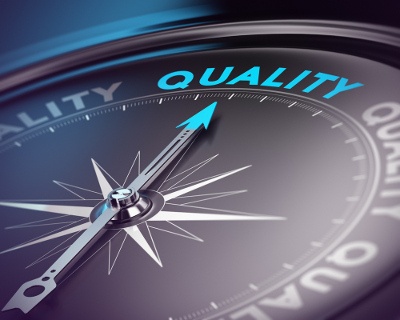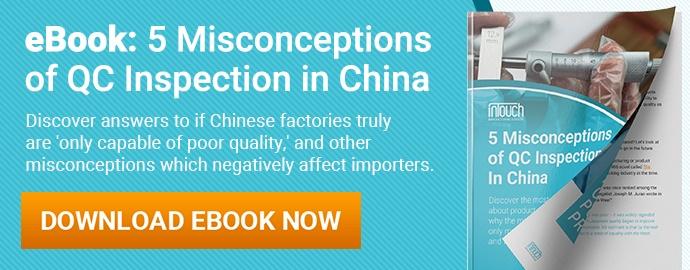Each Sunday, we publish a list of top articles and other content related to manufacturing in areas like quality control, product development, supply chain management, sourcing, auditing and law.
1. Manufacturing products with longevity
Shoddy products are a gamble. They may serve their purpose for a short while, but you probably have an underlying, gut feeling that sooner or later whatever you’re using will give out unexpectedly. Just imagine if you need to use a cheap umbrella during torrential rainfall, only to discover that its opening mechanism has gone kaput, rendering your umbrella unusable… and you soaked.
Making sure your products don’t fit this description is sometimes easier said than done. When sourcing, you may push for the best price possible from a supplier, but you may actually jeopardize product quality to save cash. So what can be done to make long-lasting products that satisfy customers?
You can:
- Implement quality control (QC) early in production – use QC checkpoints or a QC checklist early on to detect issues before they make their way into the rest of your order.
- “Avoid the inevitable inertia to compromise” – although a cheaper material might be more affordable, will it really offer the durability that your customers want? Compromising on this aspect of quality and others can add up and affect product longevity.
- Give customers a lifetime guarantee – if you want customers to believe in the durability of your product, they need to know you’ll always replace or rework a defective unit.
Selling a product that you can truly be proud of and that customers can rely on requires dedication to quality. By focusing on quality, you also focus on long-term customer satisfaction.
To maximize customer satisfaction and avoid making garbage products, check out the article in the link below:
3 Tips for Manufacturing Products That Last a Lifetime – Dave Kahng, Entrepreneur
2. Improving your supplier for mutual success
If someone offered to help you improve your manufacturing processes, would you accept?
You might be concerned about the confidential aspects of your business and how your products are made. While this is certainly a valid concern, this article examines two opposing examples. One supplier decided to engage in a supplier development relationship and the other didn’t.
The bottom line is that the supplier that was open to receiving help from its customer survived, and the one that refused it went out of business. But the receptive supplier did more than just survive – it thrived:
- On-time delivery increased 25 percent
- Parts-per-million (PPM) defects were reduced by 4,200
- Overall productivity jumped by 32 percent
- Costs dropped by 11 percent
These stats are a compelling reason for suppliers and customers to work together. Mutual cooperation leads to mutual success.
To translate this into sourcing from abroad, it might be worthwhile to consider helping your supplier improve its manufacturing so that you both benefit. You might want to suggest assisting the factory with implementing Lean manufacturing or developing a QC checklist. Or maybe you’d like to implement a production planning system. No matter the type of assistance, it can only mean good things for order quality.
If you’d like to read more about the two suppliers mentioned here, check out the full article in the link below:
A Tale of Two Suppliers – Paul Ericksen, Industry Week
3. IIoT & China
There’s a lot of promising data for the Industrial Internet of Things (IIoT). And now, when it comes to the intersection of IIoT and China, there’s good news.
This article mentions how the Chinese government projects the IIoT market in 2020 will be worth about $65 billion and has fostered upgrades to industry with initiatives like Made in China 2025. Right now, the businesses that benefit the most from the IIoT trend are component manufacturers and system integrators. But in due time, many more companies are likely to enjoy the advantages of IIoT too.
Within China, the author mentions that,
IIoT comes in various forms in China, including intelligent production processes, massive customization, cloud manufacturing platforms, collaborative manufacturing and collaborative innovation platforms, B2B industry e-commerce and intelligent product development tools.
These advanced features are still in their infancy in China and aren’t completely widespread. But in the years to come they could mean cheaper prices for importers as fewer workers are needed for production and factories implement more efficient processes.
How long do you think it will take Chinese factories to implement IIoT en masse? Let us know in the comments section below.
Check out the full article on IIoT in China by following the link below:
China Bets Big on Industrial IoT – Yorbe Zhang, EET Asia
4. Google Glass’s second wind in manufacturing
Originally, as Google Glass was unveiled, circumstances seemed to indicate it would have a promising future. Media outlets, from Time Magazine to The New Yorker and all the others in between, swooned. Fate had other plans for Glass, however. Sales of the futuristic device to the mass consumer market never materialized.
But Glass has found a way to survive. As this article points out, workers at an AGCO factory in Atlanta use the device to help assemble tractor engines, scan barcodes and reference manuals during production. The wearable tech replaced tablets that would frequently break, which caused needless setbacks. Because of using Google Glass in its factory, AGCO’s “quality checks are 20 percent faster”.
Augmented reality technology in manufacturing could be a great boon to quality control, efficiency and on-time delivery of goods. While Google Glass doesn’t come cheap ($2,000 a pop, according to this article), it still has great potential, so much so that even General Electric and Boeing are trying it out.
I personally used Google Glass in California at Google’s Venice Beach office. While it was a nifty device, to say the least, I recall saying to myself that I could never use it on a day-to-day basis. I’m glad to see, however, that it’s found a niche for industrial applications. It’s exciting to imagine that with more widespread use, Glass might be able to solve a whole mess of pesky problems in manufacturing.
If you’d like to read more about Google Glass in industry, check out the full article in the link below:
Google Glass Didn’t Disappear. You Can Find It on the Factory Floor –Tasnim Shamma, National Public Radio
5. The electrifying future of energy storage
Energy storage is a pretty remarkable technology when you think about it. Phones, flashlights, watches, pacemakers and more wouldn’t be possible without this amazing and often underappreciated technology. And the business behind energy storage is getting bigger every year.
Major players in the industry, like Tesla with its Powerpack, are just one example of a company pushing the limits of what’s possible when it comes to energy storage. It’s not alone, however.
But [Tesla] is so large and multifaceted that even someone as ambitious as Tesla's founder, Elon Musk, can't do it by himself. So far, the United States lacks the combination of entrepreneurial collaboration, government policy and nationalistic fervor that will be necessary to wrest the early lead from China, South Korea and Japan.
These countries are staunch competitors and hold quite an advantage over the U.S. when it comes to widespread lithium ion battery production. As the article mentions, they started to develop the necessary manufacturing base for lithium batteries in the early 1990s. They’re able to reap the benefits of this investment nowadays more than ever as the energy storage industry balloons.
While the Asian countries mentioned have a lead in manufacturing capabilities, it’s also worth noting that the U.S. does have some cards to play, like Tesla’s Gigafactory. Additionally, research into new, more efficient batteries with advanced chemistries could level the playing field with Asia… so long as the technology materializes, scales and is produced domestically.
What all this means for importers that need batteries in their products remains a little unclear. Will Asia still dominate the energy storage market in a few years, as it does now by producing around 88 percent of the world’s lithium-ion batteries? Or will the United State or another contender take the lead and provide the world with the advanced battery technology it needs? Only time will tell.
To get the full scoop on the energy storage market, check out the detailed article in the link below:
Energy Storage is America’s Industry to Lose – E&E News, David Ferris
We’re constantly scanning the web for top manufacturing stories and news. If you’d like to submit an article for consideration for our weekly Best in Manufacturing, send us a message and let us know.







